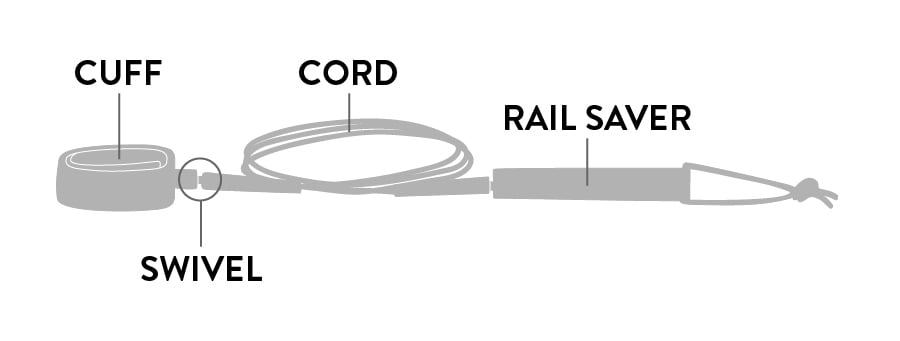How to Choose a Surfboard Leash
Invented back in '71 by Pat O’Neill, the surfboard leash has been saving people from arduous swims back to shore ever since. While leashes are meant to keep track of your board during the nastiest of wipeouts, they can and will break and should not be counted on as a lifesaving device. This means that you should never paddle out further than you can swim! This guide covers how to choose a surf leash, including areas like surf leash construction, functionality, and how to choose between an ankle and calf attachment point.
Parts of A Surf Leash

Surf Leash Cuff
These days it is pretty standard to have a double wrap-around Velcro cuff in order to add extra strength and security to your connection. Key pockets have been implemented into some cuffs and are a good option for warm water city surfers that need a place to put their car key.
Surf Leash Swivel
Some leashes have a swivel feature at their attachment point to the cuff that allows the leash to spin and twist without the rider, preventing tangles that can trip up your feet. It is up to you to decide whether you prefer a one or two bearing swivel, or none at all.
Surf Leash Rail Saver
The rail saver is the fabric that attaches the cord to the surfboard. Its job is to provide a secure connection and not put too much strain on the rail. The wider and longer the fabric, the more it will protect the rail when you fall off the board and the cord is taut. While longer and wider rail savers may offer more protection, they also create more drag on the water’s surface. It is a matter of personal preference whether you value decreased drag or increased rail protection more.
What Length Surf Leash Do You Need?
Ranging from 4’ for a grom board to a whopping 12’ for your longest longboard or SUP, there are many different leash lengths to choose from. The length of leash that is right for you will depend on the length of your board and your ability level. A leash should be equal in length to or slightly longer than the board it will be used on. This means that you should not be using the same leash on a shortboard as a longboard and vice versa.
If your board is in-between sizes, we recommend you round up to the next closest size. Sometimes beginners like to round up as much as 1’ to ensure they will be far away from their board when tumbling through the surf. Then again, one should be aware that this increases the “bail radius” of your board, meaning you are giving your board more reach to potentially hit another surfer. Length is key: a leash that is too thick or long will add unnecessary drag in the water and slow you down; a leash that is too short is more likely to cause you to fall on your board or for the board to rebound and hit you after the leash is fully stretched.
Surf Leash Thickness
There are two common leash thicknesses, often referred to as competition leashes and regular leashes. Competition leashes are usually around 3/16ths of an inch thick while a regular leash will be closer to 5/16ths of an inch thick. For all you metric users out there, that’s roughly 4.7mm and 8mm, respectively. When deciding on thickness you should consider the length of your board, wave height, and your surfing experience and ability level.
Competition Surf Leashes
These are thinner because in a competition setting, it is most important to reduce drag. Comp leashes tangle less than regular leashes due to their thinner profile and are less likely to wrap around legs or fins while waiting for waves in the lineup. Everyone has a different opinion of what wave height warrants a regular leash as opposed to the sleek competition leashes, but in general, a proficient surfer using a board under 7’ should be able to use a competition leash everywhere.
Regular Width Surf Leashes
In general, "regular" leashes are more durable due to their thickness. We encourage beginners and big wave riders to use regular leashes in order to reduce breakage caused by frequent falls or more powerful, bigger waves.
Surf Leash Attachment Point - Ankle vs Calf?
Ankle Surf Leashes
Ankle leashes are the most widely used style for several reasons. Most surfers agree that the ankle is the most comfortable spot to attach a leash, especially when paddling, and it also allows you to quickly “pull back” to your board if you crash. However, because the attachment is low on the leg, there is a higher chance for entanglement when compared to calf leashes.
Calf / Knee Surf Leashes
Calf leashes are almost always used in conjunction with a longboard or SUP. The higher attachment point is ideal for surfers who walk their board a lot and want fewer tangles and less drag in the water, but they may be less comfortable and not quite as easy to “pull back” to your board in the water.
Learn More With Our Other Surf Guides:
This is evo. We are a ski, snowboard, wake, skate, bike, surf, camp, and clothing online retailer with physical stores in Seattle, Portland, Denver, Salt Lake City, Whistler, and Snoqualmie Pass. Our goal is to provide you with great information to make both your purchase and upkeep easy.
evo also likes to travel to remote places across the globe in search of world-class powder turns, epic waves, or legendary mountain biking locations through evoTrip Adventure Travel Trips. Or, if you prefer to travel on your own, check out our ski & snowboard resort travel guides and mountain bike trail guides.
Still have questions? Please call our customer care team at 1.866.386.1590 during Customer Care Hours. They can help you find the right setup to fit your needs.